 Most viewed - MIE 三重県 Most viewed - MIE 三重県 |
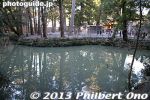
Adjacent pond.62 views
|
|
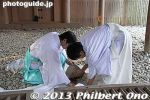
Collecting coins at Taka-no-miya Shrine 多賀宮.62 views
|
|

Ise-shi Station. 伊勢市駅62 views
|
|

The Departure Ceremony at Saiku Heian-no-mori Park gathered all the people in traditional costume. 出発式62 viewsSaiku Heian-no-mori Park (Saiku Heian Era Park) recreates one of the many rectangular blocks of the Saiku Palace area. This one reconstructs three buildings used by the head of the Saikuryo, the government office of the Saiku Palace. This main building is the Seiden (正殿) dating from the 9th century used to conduct important ceremonies by the head of the Saikuryo and to welcome official messengers from Ise Grand Shrines and Kyoto. Saio Matsuri is a tourist/community festival, not a religious festival held by any shrine. Run by a volunteer committee.
|
|

Next to Shichiri-no-watashi was Kuwana-juku's Waki-Honjin.61 views
|
|
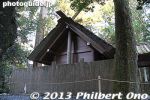
Kaze-no-miya Shrine 風宮61 views
|
|
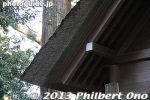
Kaze-no-miya Shrine 風宮61 views
|
|

Everyone here are volunteers, includng the festival staff behind the scenes. The festival is directed by a group (named Komachi 小町) of former Saio princesses and other characters who train the current year's festival participants.61 views
|
|

Irises in early June in Meiwa, Mie Prefecture. Meiwa's official flower. Ancient texts mention that pilgrims going to worship at Ise Shrines described it like walking on clouds of purple.61 views
|
|

The museum has this colorful Seki-juku manhole, Kameyama, Mie Prefecture. They even give you a manhole card.61 views
|
|

60 views
|
|

Shichiri-no-watashi made Kuwana properous and busy with travelers. This is a Shichiri-no-watashi marker.60 views
|
|
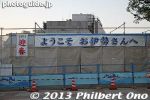
They are renovating the space in front of Ise-shi Station.60 views
|
|

Kameyama Castle manhole in Kameyama, Mie Prefecture.59 views
|
|
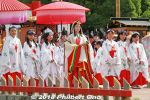
After the arrival ceremony, they held a picture-taking session with the Saio princess who posed with each group of characters. 58 viewsAnyone could take pictures. This was a great PR strategy. Obviously, social media fodder. Got some good photos of everyone.
|
|

Seki-juku is highly recommended for Tokaido stage town and architecture fans. Seki-juku manhole with a traveler design, Kameyama, Mie Prefecture.58 views
|
|

Ibi River57 views
|
|

Meiwa is a rural town (pop. 22,500) next to Ise and the site of the Saiku Palace (斎宮) where the Ise Jingu Grand Shrines' High Priestess (Saio princess) resided during the 7th–14th centuries to conduct ceremonies at Ise in place of the emperor.56 viewsThe Saio princess was an unmarried, young Imperial princess closely related to the Emperor, usually a daughter or sister. She was appointed (by divination with a turtle shell that was burnt) to be the High Priestess of Ise Grand Shrines to represent the emperor when conducting official ceremonies at the shrine a few times a year to pray for national peace and prosperity. Each time a new emperor was enthroned, a new Saio princess was appointed as the High Priestess and she traveled from Kyoto to live in the Saiku Palace in Meiwa. The journey, called "Saio Gunko," took 5 nights and 6 days through Kyoto and Shiga Prefectures and her entourage was several hundred. For about 660 years from 673 to 1334, over 60 Saio princesses served at Ise Grand Shrines. Many of them were age 5 to 15, and the oldest was 32. They served for varying periods of time, from 1 to 31 years. The High Priestess conducted prayers at the shrine for the peace, protection, welfare, and prosperity of the nation. As this sign indicates, Meiwa and Saiku is a Japan Heritage Site.
|
|
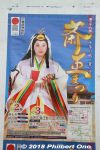
Meiwa holds the two-day Saio Matsuri (斎王まつり) festival annually on the first full weekend in June to reenact part of the Saio procession traveling from Kyoto to the Saiku Palace.55 viewsOn June 2–3, 2018, the 36th Saio Matsuri was held in Meiwa. It also happens to be the town's 60th anniversary. The festival is held near Saiku Station (Kintetsu Yamada Line) in the area where the Saiku Palace was located. It's now a large park-like area. On the festival's first day (Festival Eve) at 3:30 pm, the Misogi-no-Gi Ceremony is held at a small stream where the Saio dips her hands into the water for purification. Then they move to an outdoor stage near Saiku History Museum to conduct an evening ceremony and entertainment program from 5 pm to 9 pm. (In the case of rain, the event will be canceled.)
|
|

Miss International pearl crown48 views
|
|

47 views
|
|

47 views
|
|

Mikimoto Pearl Crown46 views
|
|

Mikimoto's Five-Storied Pagoda (御木本五重塔). Exhibited at Sesquicentennial Exposition in Philadelphia, 1926. It has 12,760 pearls.46 views
|
|

Lake Biwa pearl mussel (Hyriopsis schlegelii イケチョウガイ) endemic to Lake Biwa.45 views
|
|

The pearls are removed from the innards with this machine.45 views
|
|

45 views
|
|

Fujita Sukeyo, Fujita Masayo, and Mikimoto Kokichi.45 views
|
|

Pioneers of pearl cultivation.44 views
|
|

43 views
|
|

Liberty Bell, exhibited at the 1939 New York World's Fair. Has 12,250 pearls and 366 diamonds.43 views
|
|

Fujita Masayo who pioneered freshwater pearl cultivation at Lake Biwa.43 views
|
|

43 views
|
|

A statue of Kokichi Mikimoto and a giant pearl near Toba Station greets visitors. Erected in 1993 to mark the 100th anniversary of Mikimoto's success in pearl cultivation.42 views
|
|

42 views
|
|

View from the museum's 2nd floor.42 views
|
|

42 views
|
|

Bridge to Mikimoto Pearl Island.41 views
|
|

Buttons from oyster shells.41 views
|
|
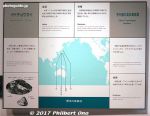
Freshwater pearl cultivation41 views
|
|

Lake Biwa pearl mussel (Hyriopsis schlegelii イケチョウガイ) endemic to Lake Biwa.41 views
|
|
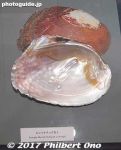
Hyriopsis cumingi41 views
|
|

Room exhibiting jewelry made of natural pearls.41 views
|
|

41 views
|
|

Mikimoto Pearl Island40 views
|
|

The removed pearls are washed.40 views
|
|

Room exhibiting jewelry made of cultured pearls.40 views
|
|

At the G7 Summit in 2016, the world leaders wore a lapel pins made of pearls.40 views
|
|

Toba Station40 views
|
|

39 views
|
|

39 views
|
|

39 views
|
|

Spectator stand for pearl diver demonstrations.39 views
|
|

The pearl divers arrive on a small boat.39 views
|
|

They are actually shellfish divers. They don't dive for pearls.39 views
|
|

Akoya oysters39 views
|
|

39 views
|
|

39 views
|
|

39 views
|
|

Making the nucleus to be inserted into the oyster.39 views
|
|
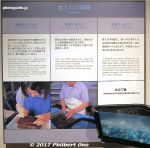
Embedding the nucleus into the oyster.39 views
|
|

Embedding the nucleus into the oyster.39 views
|
|

Instruments for embedding the nucleus into the oyster. Like a dentist.39 views
|
|

39 views
|
|

Harvesting39 views
|
|

39 views
|
|

39 views
|
|

Special Exhibition Room displaying pearl crowns in Jan. 2017.39 views
|
|

39 views
|
|

39 views
|
|

39 views
|
|

Toba Station39 views
|
|

Entrance to the bridge to Mikimoto Pearl Island. Pay admission first.38 views
|
|

Mikimoto Pearl Island is full of monuments.38 views
|
|

38 views
|
|

I went in Jan. so almost no one was here.38 views
|
|

Air and water temperatures in Jan.38 views
|
|

The pearl divers are very friendly. They wave to you.38 views
|
|

They drop into the ocean one by one with their floating buckets.38 views
|
|
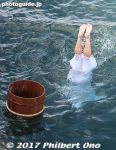
Diving for shellfish.38 views
|
|

38 views
|
|

A narrator explains what the divers are doing and what they caught.38 views
|
|

Pearl Museum is a comprehensive museum about pearl cultivation mainly in Japan.38 views
|
|
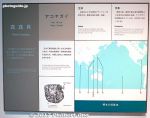
38 views
|
|
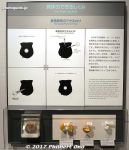
38 views
|
|

Making the nucleus to be inserted into the oyster.38 views
|
|

38 views
|
|

G7 Summit was held in Mie (Ise-Shima) in 2016.38 views
|
|

38 views
|
|

The same lapel pin worn by the leaders was on sale for ¥24,300.38 views
|
|

38 views
|
|

Mikimoto Kokichi 38 views
|
|
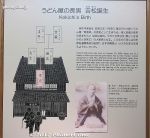
38 views
|
|

38 views
|
|

38 views
|
|
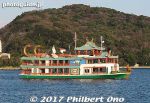
Boat for Dolphin Island.38 views
|
|

JR Toba Station38 views
|
|

Bridge to Mikimoto Pearl Island.37 views
|
|

Entrance to Mikimoto Pearl Island.37 views
|
|

37 views
|
|

37 views
|
|

37 views
|
|

37 views
|
|

37 views
|
|

Statue of Mikimoto Kokichi.37 views
|
|

37 views
|
|

37 views
|
|

Ama divers at Mikimoto Pearl Island37 views
|
|

37 views
|
|

37 views
|
|
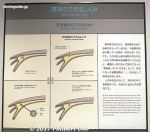
Formation of natural pearls.37 views
|
|

Making the nucleus to be inserted into the oyster.37 views
|
|

Embedding the nucleus into the oyster.37 views
|
|
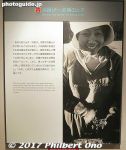
37 views
|
|

The oysters' innards embedded with pearls are taken out of the shell and dropped through a hole into a bucket below. 37 views
|
|
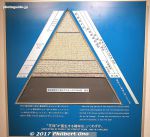
Only a small percentage of harvested pearls are perfect.37 views
|
|

37 views
|
|

To weigh the pearl37 views
|
|

To drill holes into the pearl.37 views
|
|
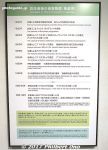
37 views
|
|

37 views
|
|

Walking path around the island.37 views
|
|

Rock garden outside Mikimoto Kokichi Memorial Hall37 views
|
|

Ticket booth for boat rides to nearby Dolphin Island.37 views
|
|

Gift shop at Toba Station.37 views
|
|
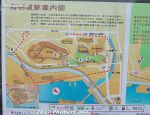
Only a few stone walls and a well remain. No buildings. It was once the administrative center for the Toba Domain. The last occupants was the Inagaki Clan.37 views
|
|

Shiroyama Park at Toba Castle.37 views
|
|

About Toba Castle's main tenshu tower.37 views
|
|

Bridge to Mikimoto Pearl Island.36 views
|
|

36 views
|
|
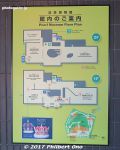
Floor plan of Pearl Museum.36 views
|
|

36 views
|
|

36 views
|
|

36 views
|
|

36 views
|
|

To measure the pearl's size.36 views
|
|

36 views
|
|

Mikimoto Kokichi Memorial Hall36 views
|
|

Mikimoto Kokichi Memorial Hall36 views
|
|
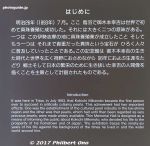
About Mikimoto Kokichi Memorial Hall36 views
|
|

Mikimoto Kokichi Memorial Hall36 views
|
|

36 views
|
|

36 views
|
|

Scenic views on the way to Toba.36 views
|
|

Toba Station36 views
|
|

36 views
|
|

About the well.36 views
|
|
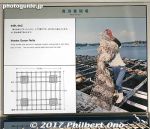
35 views
|
|

35 views
|
|

Portrait of G7 summit leaders at ise-Shima.35 views
|
|

Toba Castle is a short walk from Toba Station.35 views
|
|

Go up these stairs for Toba Castle.35 views
|
|

35 views
|
|

Toba Castle site is on a small hilltop overlooking Mikimoto Pearl Island.35 views
|
|

Way to the Honmaru.35 views
|
|

35 views
|
|

35 views
|
|

About Toba Castle.35 views
|
|

35 views
|
|

35 views
|
|

Site of Toba Castle's main tower.35 views
|
|

35 views
|
|

35 views
|
|

Part of the castle site is Shiroyama Park with nice views of the pearl island. 34 views
|
|

Shiroyama Park at Toba Castle.34 views
|
|

Shiroyama Park at Toba Castle.34 views
|
|

About Shiroyama Park at Toba Castle.34 views
|
|

About the castle wall.34 views
|
|

34 views
|
|

34 views
|
|

34 views
|
|

34 views
|
|

Saiku Heian-no-mori Park recreates one of the many rectangular blocks of the Saiku Palace area. This one reconstructs three buildings used by the head of the Saikuryo, the government office of the Saiku Palace. 33 viewsThe left building is the Nishiwakiden, center is Seiden (main building), and right building is the Higashiwakiden. The buildings are only approximations of what they actually looked like. Only the size could be determined from pillar holes, but not the actual apperance. This is where the Saio Matsuri festival's Departure Ceremony is held.
|
|
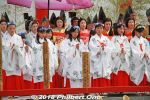
Warawame (童女) daughters of the Imperial family or nobility. They wear chihaya costume. 千早31 views
|
|

This main building is the Seiden dating from the 9th century used to conduct important ceremonies by the head of the Saikuryo and to welcome official messengers from Ise Grand Shrines and Kyoto.31 viewsNormally open to the public, free admission. 正殿
|
|

This brown building was the Saio's modest living quarters. Not as large as you would expect.28 views
|
|
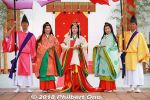
Posing with top-ranking court ladies called the Naishi (内侍) working at the Saiku Palace. They have fancy umbrella bearers called furyu-gasa. 風流傘27 views
|
|
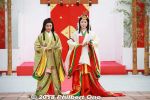
Posing with the Nyo-betto (女別当) who was the supervisor of the court ladies at special occasions such as the Saio procession. 27 views
|
|

On the second day, the Departure Ceremony is held here at the Saiku Heian-no-mori Park where a few Heian Period structures have been reconstructed. They had a large blue tarp on the ground for spectators.26 viewsSecond day is the main event. There's the Departure Ceremony and Saio Gunko Procession. The Departure Ceremony reenacts the Saio's departure from Kyoto for her journey to Saiku Palace.
At 1 pm, the Departure Ceremony is held at Saiku Heian-no-mori Park where a few Heian-Period buildings have been reconstructed. At 2 pm, the 120 people dressed in Heian-Period costumes walk in a colorful procession called the "Saio Gunko" to an outdoor stage near the Saiku History Museum. The Saio princesses are carried in their own palanquins. It's a short walk.
On the outdoor stage, they hold a ceremony and picture-taking session from 2:45 pm. Everything ends by 3:30 pm. I went to see the festival on the second day on June 3, 2018. In the case of rain, the event will be canceled.
If you want to get close, you need to arrive earlier than the 1 pm starting time. Short walk from Saiku Station.
|
|

In 2018, the Saio princess was portrayed by 26-year-old Nakaho Yuri (中保 友里) from Tsu, Mie. She was selected from among 27 applicants. It was her fourth time to apply for this honor and was finally selected. 26 viewsIt's confusing that she's called the 34th Saio at the 36th Saio Matsuri. It's because the festival didn't have a Saio from the 1st festival. She served well.
|
|

Everyone quickly dissipated and all the food stalls closed up. It was only 3:30 pm.26 views
|
|

JR Kameyama Station platform and tracks.26 views
|
|

Large crowd sitting on the tarp and watching the departure ceremony. It's pretty hot under the sun.25 views
|
|

Nara Period (8th century) sacred dance (舞樂蘭陵王).25 viewsGagaku music was performed by Kogakkan University's Gagaku club seen in the background. 皇學館大学 雅楽部
|
|
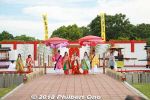
Posing with top-ranking court ladies called the Naishi (内侍) working at the Saiku Palace. They have fancy umbrella bearers called furyu-gasa. 風流傘25 views
|
|
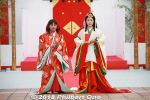
Child Saio princess and adult Saio princess.25 views
|
|

The Saio princess wears a juni-hitoe (12-layer) robe reserved only for female Imperial family members or women marrying into the Imperial family.25 views
|
|

The Saio gives farewell remarks before leaving her family in Kyoto for Saiku. See the video to hear what she said.25 views
|
|

JR Kameyama Station platform.25 views
|
|

In 2018, the child Saio princess was portrayed by 10-year-old Nishimura Manami (西村 まなみ) from Meiwa. She was selected by lot from a number of girls. Not all Saio princesses were adults, some were a child. 子供斎王24 views
|
|

Ranryo-o court dance originally came from China and was a warrior hero dance. (舞樂蘭陵王).24 views
|
|
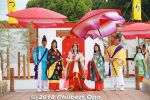
Posing with top-ranking court ladies called the Naishi (内侍) working at the Saiku Palace. They have fancy umbrella bearers called furyu-gasa. 風流傘24 views
|
|
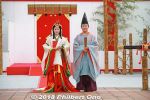
Posing with the Emperor's Messenger who is the highest ranking person in the procession. (Konoe Tsukai). 近衛使24 views
|
|

The actual road where the Saio princess traveled to Ise Grand Shrines. Called "Kodai Ise-do" (Ancient Ise Road). 古代伊勢道24 views
|
|

After the festival is over, be sure to visit the Saiku Historical Museum nearby. See this album.24 views
|
|

Old Tokaido Road in Seki-juku. Picturesque.24 views
|
|

People wore Heian Period (794–1185) costumes from when Kyoto was the capital of Japan. These are Saiku government officials. 斎宮十二司官人23 views
|
|

Dancers called Maibito (舞人).23 views
|
|

High-ranking court ladies called Uneme (釆女) chosen from an aristocratic family. They were in charge of food and drink for the princess.23 views
|
|

The procession is about to leave the starting point at around 2 pm. Purple irises is another symbol of Meiwa, probably why they hold the festival in June.23 views
|
|

Saio princess in a palanquin in Meiwa, Mie Prefecture.23 views
|
|

23 views
|
|
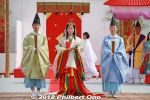
Saiku government officials. 斎宮十二司官人23 views
|
|
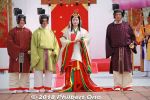
Kadono-osa, the security detail. They hold a tachi sword. 看督長23 views
|
|
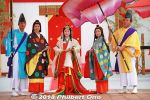
Posing with top-ranking court ladies called the Naishi (内侍) working at the Saiku Palace. They have fancy umbrella bearers called furyu-gasa. 風流傘23 views
|
|
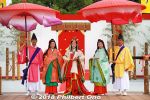
Posing with top-ranking court ladies called the Naishi (内侍) working at the Saiku Palace. They have fancy umbrella bearers called furyu-gasa. 風流傘23 views
|
|
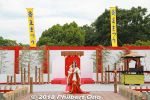
Yellow banners read "Saio Matsuri" (Saio Festival).23 views
|
|

Sign saying "Saiku" which was designated as a National Historic Site in 1979. 国史跡23 views
|
|

Saiku Heian-no-mori Park (さいくう平安の杜) opened in Oct. 2015 with three reconstructed buildings.23 views
|
|

Today, Meiwa is a sleepy little town bypassed by most tourists going to Ise or Toba. Official Saiku info23 views
|
|

The Child Saio princess offer an iris flower. 子ども斎王23 views
|
|
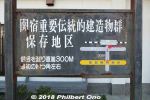
Way to Seki-juku.23 views
|
|

23 views
|
|
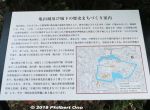
History of Kameyama Castle town.23 views
|
|

Seki-juku was the 47th station or lodging/post town on the old Tokaido Road. It well retains a traditional townscape with a good number of traditional Edo Period buildings including the Honjin and Waki Honjin. 23 viewsSeki-juku is preceded by Kameyama-juku and followed by Sakashita-juku. All three are in the present-day city of Kameyama. Hiroshige also created this woodblock print of Seki-juku in the 1830s. It depicts daimyo staff preparing to leave the Honjin lodge before dawn (notice the still dark sky). Unknown which Honjin it is. (Seki had two Honjin.)
|
|

Myobu (命婦) getting off the Seiden.22 views
|
|

Court ladies called Nyoju (女嬬) who serve in the inner palace (後宮) and take care of the Saio princess' daily living.22 views
|
|

Naishi (内侍) and the Nyo-betto leads the Child Saio princess.22 views
|
|

The Saio princess appeared from the Seiden and gave an offering of an iris flower and prayed toward Ise Grand Shrines.22 viewsThe Saio was an unmarried, young Imperial princess, often the Emperor's daughter, who was appointed (by divination) to be the High Priestess of Ise Grand Shrines to pray for national peace and prosperity a few times a year in place of the emperor.
|
|

The departure ceremony included live gagaku sacred music and a Nara Period (8th century) sacred dance called Ranryo-o. (舞樂蘭陵王). 22 viewsGagaku music was performed by Kogakkan University's Gagaku club. It's a Shinto university in Ise. 皇學館大学 雅楽部
|
|

Saio Matsuri Departure Ceremony at Seiden Hall, Saiku Heian-no-mori Park. 正殿22 views
|
|

Saio princess gave a farewell speech.22 views
|
|

After the Departure Ceremony, the Saio exits showing her long, flowing black hair.22 views
|
|

Saio Woods 斎王の森22 views
|
|
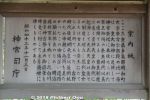
Saio Woods explanation as of 1968.22 views
|
|

The Saio Gunko Procession started at around 2 pm.22 views
|
|

22 views
|
|

Child Saio princess. 子供斎王22 views
|
|

Child Saio princess. 子供斎王22 views
|
|
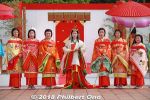
Posing with court ladies called Nyoju (女嬬) who serve in the inner palace (後宮) and take care of the Saio princess' daily living.22 views
|
|

Opened in Oct. 1999, Itsukinomiya Hall for Historical Experience is in the same area. Various hands-on activities like weaving and dressing in Heian-Period costumes. Open 9:30 am–5 pm, closed Mondays. Admission free. いつきのみや歴史体験館22 views
|
|
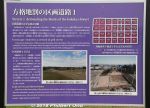
Meiwa town has been excavating Saiku Palace digs all over the place. They found pillar holes, pottery, etc. The digs will continue for many more years. Relics are displayed in the local museum. 22 views
|
|
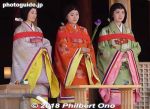
Iris flower offerings followed. Leading court ladies called the Myobu (命婦), assistants who tend to the immediate needs of the Saio princess. 献花の儀式22 views
|
|

The Nyo-betto (女別当), who was the supervisor of the court ladies at special occasions such as the Saio procession, offer an iris flower.22 views
|
|

Line of stumps indicate the position of pillars of a fence that surrounded the Saio's Palace.22 views
|
|

JR Seki Station building has a traditional design. It also houses a tourist information office and exhibition space. From Nagoya, it's about 22 views
|
|

22 views
|
|

22 views
|
|

Antique shop sign.22 views
|
|

During the Edo Period, Kameyama Castle was the Ise-Kameyama Domain headquarters and center of Kameyama-juku lodging town on the Tokaido Road.22 viewsIt still has the Tamon-yagura turret (open to the public), castle walls, and a partially reconstructed Ninomaru keep. Short walk from JR Kameyama Station (JR Kansai Line).
|
|

Kameyama Castle's Tamon-yagura turret in autumn. 多聞櫓22 views
|
|
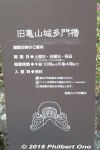
Kameyama Castle's Tamon-yagura turret is open 10 am to 4 pm, free admission. Unfortunately, I arrived after it closed.22 views
|
|

Kameyama Castle's Tamon-yagura turret.22 views
|
|

22 views
|
|

Tamon-yagura turret.22 views
|
|
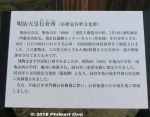
About the lodging for Emperor Meiji when he passed through Kameyama in 1880.22 views
|
|

22 views
|
|

Saiku government officials. 斎宮十二司官人21 views
|
|

Myobu (命婦) getting off the Seiden.21 views
|
|

High-ranking court ladies called Uneme (釆女) chosen from an aristocratic family. They were in charge of food and drink for the princess. They give an iris flower offering.21 views
|
|

Top-ranking court ladies called the Naishi (内侍) working at the Saiku Palace.21 views
|
|

Top-ranking court ladies called the Naishi (内侍) working at the Saiku Palace.21 views
|
|
| 1114 files on 5 page(s) |
 |
3 |  |
|